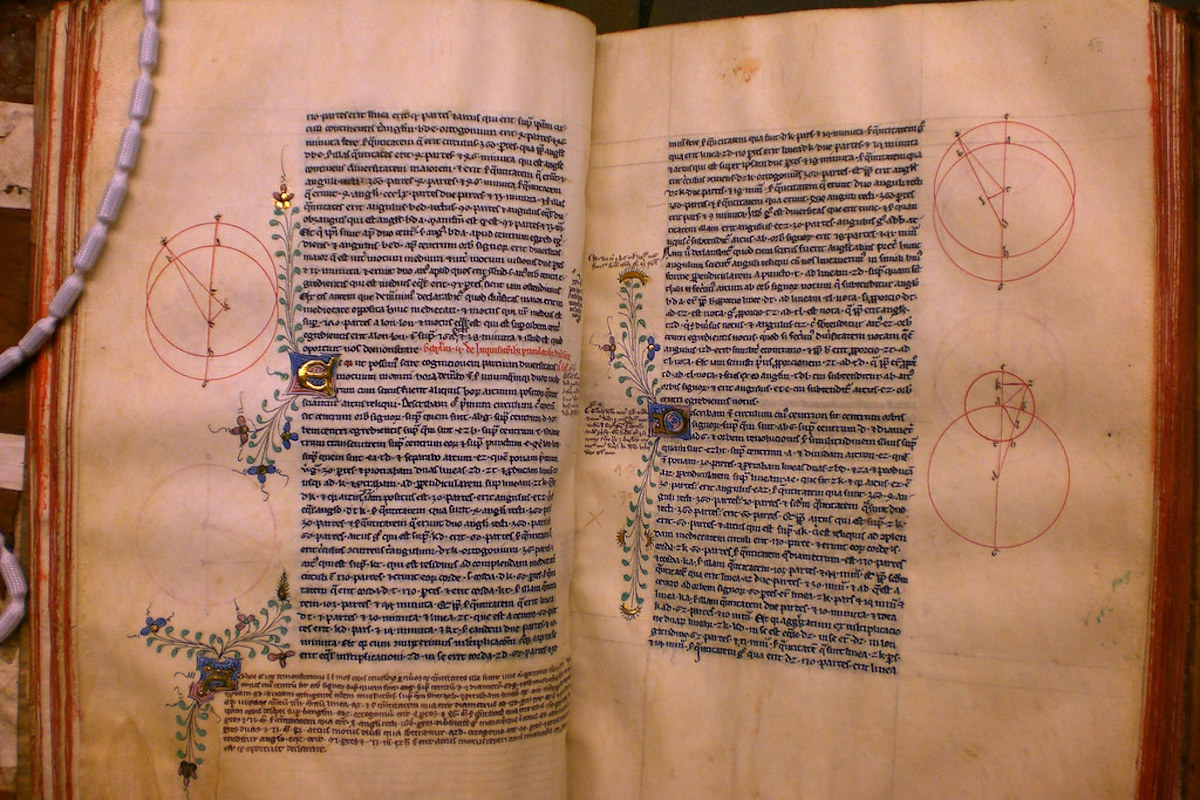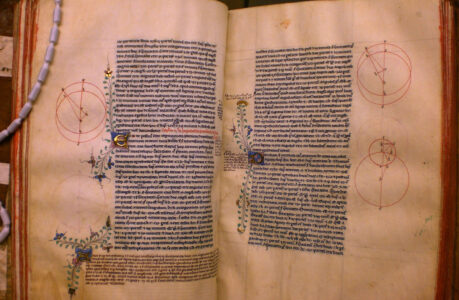The Almagest is a seminal work in the field of astronomy, written by the Greek mathematician and astronomer Claudius Ptolemy in the 2nd century CE. The book was a culmination of centuries of astronomical observations and calculations, and it synthesized the knowledge of the ancient Greeks, Babylonians, and Egyptians into a comprehensive and systematic framework that would influence the study of astronomy for centuries to come.
At its core, the Almagest is a treatise on the motion of the celestial bodies, including the sun, moon, planets, and stars. Ptolemy used a complex system of geometric models and calculations to explain the apparent motions of these bodies in the sky, and his work laid the foundation for modern astronomy and astrophysics.
One of the most important contributions of the Almagest was its detailed description of the geocentric model of the universe. According to this model, the earth was at the center of the universe, with the sun, moon, and planets revolving around it in concentric circles. This view of the universe was widely accepted for centuries, and it influenced not only astronomy but also philosophy and religion.
Ptolemy’s geocentric model was based on the observations of the ancient Greeks and Babylonians, who had charted the motions of the stars and planets over thousands of years. Ptolemy refined and expanded upon these observations, using sophisticated mathematical techniques to predict the positions of the celestial bodies with remarkable accuracy.
One of the key tools that Ptolemy used in his calculations was the astrolabe, a complex instrument that allowed astronomers to measure the positions of the stars and planets with great precision. Ptolemy’s descriptions of the astrolabe and other astronomical instruments in the Almagest were so detailed and accurate that they were still being used by astronomers centuries later.
In addition to his work on the geocentric model of the universe, Ptolemy also made important contributions to the study of optics and astronomy. He wrote extensively on the properties of light and the nature of vision, and his work on optics influenced the development of the telescope and other optical instruments.
Ptolemy’s influence on the field of astronomy was immense, and his ideas continued to shape scientific thought for centuries. The Almagest was translated into Arabic in the 9th century, and it became a cornerstone of Islamic astronomy and science. It was also translated into Latin in the 12th century, and it played a crucial role in the European Renaissance and the scientific revolution that followed.
Despite its historical significance, the Almagest was not without its flaws. The geocentric model of the universe was eventually replaced by the heliocentric model, first proposed by the Polish astronomer Nicolaus Copernicus in the 16th century. The heliocentric model placed the sun at the center of the solar system, with the earth and other planets revolving around it, and it provided a simpler and more accurate explanation for the motions of the celestial bodies.
However, the Almagest remains a testament to the ingenuity and perseverance of the ancient astronomers who charted the skies and laid the foundation for modern science. It is a testament to the power of human curiosity and the boundless potential of the human mind to unravel the mysteries of the universe.
Claudius Ptolemy
Claudius Ptolemy was a Greek mathematician, astronomer, and geographer who lived in the 2nd century CE. He was born in Egypt, and he spent much of his life in Alexandria, which was then a center of learning and scholarship.
Ptolemy is best known for his work in astronomy, particularly his treatise on the motion of the celestial bodies, the Almagest. This work was a culmination of centuries of astronomical observations and calculations, and it synthesized the knowledge of the ancient Greeks, Babylonians, and Egyptians into a comprehensive and systematic framework that would influence the study of astronomy for centuries to come.
Ptolemy’s geocentric model of the universe, which placed the earth at the center of the universe with the sun, moon, and planets revolving around it in concentric circles, was widely accepted for centuries, and it influenced not only astronomy but also philosophy and religion.
In addition to his work on astronomy, Ptolemy also made important contributions to the study of optics and geography. His work on optics, particularly his treatise on the nature of light and vision, influenced the development of the telescope and other optical instruments.
Ptolemy’s work had a profound influence on the development of science and technology in the centuries that followed. The Almagest was translated into Arabic in the 9th century, and it became a cornerstone of Islamic astronomy and science. It was also translated into Latin in the 12th century, and it played a crucial role in the European Renaissance and the scientific revolution that followed.
Despite the fact that some of Ptolemy’s ideas have been superseded by more modern theories, his work remains an important part of the history of science and a testament to the power of human curiosity and the boundless potential of the human mind to unravel the mysteries of the universe.
The geocentric model
The geocentric model of the universe was a cosmological model that placed the earth at the center of the universe, with the sun, moon, and planets revolving around it in concentric circles. This view of the universe was widely accepted in the ancient world and persisted for centuries until the heliocentric model was proposed by Nicolaus Copernicus in the 16th century.
The geocentric model was based on the observations of the ancient Greeks and Babylonians, who had charted the motions of the stars and planets over thousands of years. The model was developed in order to explain the apparent motions of the celestial bodies as they moved across the sky. The motion of the stars was seen as being caused by the rotation of the celestial sphere around the earth, while the motions of the planets were explained as being caused by the planets themselves moving along complex, looping paths in the sky.
One of the key features of the geocentric model was the use of epicycles and deferents to explain the motions of the planets. An epicycle was a small circle whose center moved along the circumference of a larger circle, called the deferent. The planet was located at a point on the epicycle, and as the epicycle moved around the deferent, the planet would appear to move in a complex looping pattern.
The geocentric model was developed and refined over centuries, and it was considered to be the most accurate model of the universe for many centuries. It was widely accepted in the ancient world, and it influenced not only astronomy but also philosophy and religion. The Ptolemaic system, which was developed by Claudius Ptolemy in the 2nd century CE, was the most detailed and sophisticated version of the geocentric model, and it was used as the standard model of the universe for over a thousand years.
Despite its historical significance, the geocentric model was eventually replaced by the heliocentric model, which placed the sun at the center of the solar system, with the earth and other planets revolving around it. The heliocentric model was first proposed by Copernicus in the 16th century, and it provided a simpler and more accurate explanation for the motions of the celestial bodies.
The heliocentric model eventually became widely accepted, and it marked a major shift in scientific thinking about the nature of the universe. However, the geocentric model remains an important part of the history of science, and it is a testament to the ingenuity and perseverance of the ancient astronomers who charted the skies and laid the foundation for modern science.

